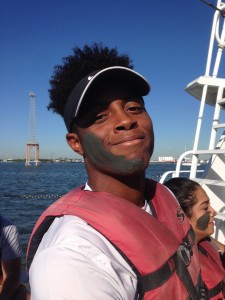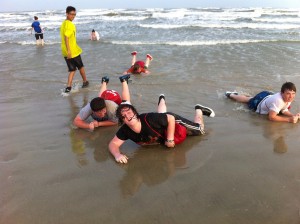Lakehill Preparatory School biology students recently spent five days in Galveston, adding hands-on experience to their classroom lessons. Students visited the NOAA turtle research facility in Galveston where they raise loggerhead sea turtles to use in testing the turtle exclusion devices required in all shrimp and fish nets. They visited the salt marsh and captured dozens of fish and invertebrates to discover what kind of animals live in that habitat. They also learned about the value of the salt marsh to human society, including its role in controlling flood waters, holding the soil in place, and detoxifying the water of chemical run-off from farms and urban areas. Students were also able to understand how freshwater rivers mix with ocean water by measuring the salinity and water clarity.
Students were able to sample marine life in the deeper water of the Houston Shipping Channel using a trawl net similar to what shrimpers use to haul in their catch. They caught a variety of fishes as well as a few invertebrates. They then returned to the salt marsh for a 2.5-mile kayak tour through small channels of water, allowing them to get a close-up view into salt grass habitats far from human disturbance. Students gained a better appreciation for the detail of this habitat by painting a water-color portrait of the scenery. “I think it helped students understand that we need both a scientific understanding of the biome and a personal artistic connection with the habitat to create policies to help preserve it for future generations,” said Biology teacher and trip sponsor Jeremy Holman.
The group enjoyed a tour of the Houston Museum of Natural Science, which houses one of the finest paleontology exhibits in the country. At Brazos Bend State Park, they hiked around the lakes that are home to a robust alligator population. They also participated in a space station simulation and had a star-gazing party hosted by professional astronomers at the George Observatory. In the simulation, students assumed roles in navigation, communication, engineering, geology, biology, life support, and medical to successfully land a probe on the surface of the moon. This team-building exercise is used by corporations throughout Houston, and Lakehill students solved every challenge in under an hour to complete the mission. Through the 36-inch domed telescopes, they were able to see Saturn and Mars, various star clusters, and several nebula (planet- or star-forming dust clouds) in deep space.
They ended their adventure with a visit to the Kemah Boardwalk, where they fed sardines to the stingrays in the aquarium and rode on the various amusement rides, including the famed Boardwalk Bullet wooden roller coaster.

